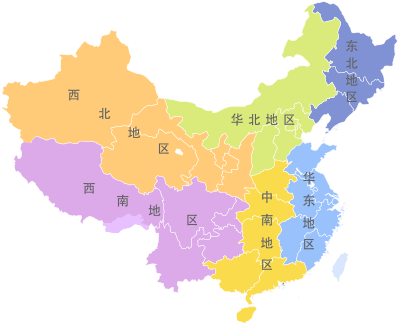Ningxia
| Ningxia Hui Autonomous Region 宁夏回族自治区 | |
|---|---|
| Autonomous region | |
| Name transcription(s) | |
| • Chinese | 宁夏回族自治区 (Níngxià Huízú Zìzhìqū) |
| • Abbreviation | simplified Chinese: 宁; traditional Chinese: 寧; pinyin: Níng |
|
Map showing the location of the Ningxia Hui Autonomous Region | |
| Named for |
宁 níng—tranquil 夏 xià—Western Xia "Tranquil Xia" |
| Capital (and largest city) | Yinchuan |
| Divisions | 5 prefectures, 21 counties, 219 townships |
| Government | |
| • Secretary | Li Jianhua |
| • Chairwoman | Xian Hui (acting) |
| Area[1] | |
| • Total | 66,399.73 km2 (25,637.08 sq mi) |
| Area rank | 27th |
| Population (2010)[2] | |
| • Total | 6,301,350 |
| • Estimate (31 December 2014)[3] | 6,620,000 |
| • Rank | 29th |
| • Density | 89.1/km2 (231/sq mi) |
| • Density rank | 25th |
| Demographics | |
| • Ethnic composition |
Han: 62% Hui: 34% Manchu: 0.4% |
| • Languages and dialects | Lanyin Mandarin, Zhongyuan Mandarin |
| ISO 3166 code | CN-64 |
| GDP (2015) |
CNY 291.2 billion US$ 46.8 billion (29th) |
| - per capita |
CNY 43,805 US$ 7,033 (17th) |
| HDI (2010) | 0.674[4] (medium) (21st) |
| Website | http://www.nx.gov.cn/ |
| Ningxia | |||||||||||||||||||||||||||||||||||||||
|
"Ningxia" in Simplified (top) and Traditional (bottom) Chinese characters | |||||||||||||||||||||||||||||||||||||||
| Simplified Chinese | 宁夏 | ||||||||||||||||||||||||||||||||||||||
|---|---|---|---|---|---|---|---|---|---|---|---|---|---|---|---|---|---|---|---|---|---|---|---|---|---|---|---|---|---|---|---|---|---|---|---|---|---|---|---|
| Traditional Chinese | 寧夏 | ||||||||||||||||||||||||||||||||||||||
| Xiao'erjing | نٍ ﺷﯿَا | ||||||||||||||||||||||||||||||||||||||
| Postal | Ningsia | ||||||||||||||||||||||||||||||||||||||
| |||||||||||||||||||||||||||||||||||||||
| Ningxia Hui Autonomous Region | |||||||||||||||||||||||||||||||||||||||
| Simplified Chinese | 宁夏回族自治区 | ||||||||||||||||||||||||||||||||||||||
| Traditional Chinese | 寧夏回族自治區 | ||||||||||||||||||||||||||||||||||||||
| Xiao'erjing | نٍ ﺷﯿَا ﺧُﻮِ ذُﻮْ ذِ جِ ﺛُﻮْ | ||||||||||||||||||||||||||||||||||||||
| Postal | Ningsia Hui Autonomous Region | ||||||||||||||||||||||||||||||||||||||
| |||||||||||||||||||||||||||||||||||||||
Ningxia (Chinese: 宁夏; pronounced [nǐŋɕi̯â], Xiao'erjing: نٍ ﺷﯿَا ﺧُﻮِ ذُﻮْ ذِ جِ ﺛُﻮْ), officially the Ningxia Hui Autonomous Region (NHAR), is an autonomous region of the People's Republic of China located in the northwest part of the country. Formerly a province, Ningxia was incorporated into Gansu in 1954 but was separated from Gansu in 1958 and was reconstituted as an autonomous region for the Hui people, one of the 56 officially recognised nationalities of China. Twenty percent of China's Hui population lives in Ningxia.[5]
Ningxia is bounded by Shaanxi to the east, Gansu to the south and west, and Inner Mongolia Autonomous Region to the north and has an area of around 66,400 square kilometres (25,600 sq mi).[1] This sparsely settled, mostly desert region lies partially on the Loess Plateau and in the vast plain of the Yellow River, and features the Great Wall of China along its northeastern boundary. Over the years an extensive system of canals has been built. Extensive land reclamation and irrigation projects have made increased cultivation possible.
History
Ningxia and its surrounding areas were incorporated into the Qin Dynasty as early as the 3rd century BC. Throughout the Han Dynasty and the Tang Dynasty there were several large cities established in the region. The Liang Province Rebellion at the end of the Han Dynasty affected Ningxia.
By the 11th century the Tangut people had established the Western Xia Dynasty on the outskirts of the then-Song Dynasty. Jews also lived in Ningxia, as evidenced by the fact that, after a major flood destroyed Torah scrolls in Kaifeng, a replacement was sent to the Kaifeng Jews by the Ningbo and Ningxia Jewish communities.[6]
It then came under Mongol domination after Genghis Khan conquered Yinchuan in the early 13th century. Muslims from Central Asia also began moving into Ningxia from the west. The Muslim Dungan Revolt of the 19th century affected Ningxia.
In 1914, Ningxia was merged with the province of Gansu. However, in 1928 it was detached from Gansu and became a separate province. Between 1914 and 1928, the Xibei San Ma (literally "three Mas of the northwest") ruled the provinces of Qinghai, Ningxia and Gansu. Muslim Kuomintang General Ma Hongkui was the military governor of Ningxia and had absolute authority in the province. The Muslim conflict in Gansu, which lasted from 1927 to 1930, spilled over into Ningxia. From 1950 to 1958, a Kuomintang Islamic insurgency resulted in fighting throughout Northwest China, including Ningxia. In 1954, the Chinese government merged Ningxia with Gansu, but in 1958 Ningxia formally became an autonomous region of China. In 1969, Ningxia received a part of the Inner Mongolian Autonomous Region, but this area was returned in 1979.
A number of Chinese artifacts dating from the Tang dynasty and Song dynasty, some of which had been owned by Emperor Zhenzong, were excavated and then came into the hands of Ma Hongkui, who refused to publicize the findings. Among the artifacts were a white marble tablet from the Tang dynasty, gold nails, and bands made out of metal. It was not until after Ma died that his wife went to Taiwan in 1971 from America to bring the artifacts to Chiang Kai-shek, who turned them over to the Taipei National Palace Museum.[7]
In Xiji at a Mosque, a panic rush caused 14 deaths.[8][9]
Geography
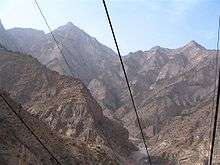
Ningxia borders the provinces of Shaanxi and Gansu, and the Inner Mongolia Autonomous Region.
The Yellow River flows through Ningxia. The Ningxia ecosystem is one of the least studied regions in the world. Some plant genera in Ningxia have been estimated at over 40,000 years old.
Ningxia is a relatively dry, desert-like region. Significant irrigation supports the growing of wolfberries, a commonly consumed fruit throughout the region.
Ningxia's deserts include the Tengger desert in Shapotou.
The northern section, through which the Yellow River flows, supports the best agricultural land. A railroad, linking Lanzhou with Baotou, crosses the region. A highway has been built across the Yellow River at Yinchuan.
On 16 December 1920, the Haiyuan earthquake, 8.6 magnitude, at 36°36′N 105°19′E / 36.6°N 105.32°E, initiated a series of landslides that killed an estimated 200,000 people. Over 600 large loess landslides created more than 40 new lakes.[10][11]
| Part of a series on:
Islam in China | ||||||
|---|---|---|---|---|---|---|
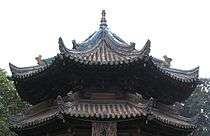 | ||||||
|
||||||
|
| ||||||
In 2006, satellite images indicated that a 700 by 200-meter fenced area within Ningxia—5 km (3.1 mi) southwest of Yinchuan, near the remote village of Huangyangtan—is a near-exact 1:500 scale terrain model reproduction of a 450 by 350-kilometer area of Aksai Chin bordering India, complete with mountains, valleys, lakes and hills. Its purpose is as yet unknown.[12][13]
Climate
The region is 1,200 kilometres (750 mi) from the sea and has a continental climate with average summer temperatures rising to 17 to 24 °C (63 to 75 °F) in July and average winter temperatures dropping to between −7 to −15 °C (19 to 5 °F) in January. Seasonal extreme temperatures can reach 39 °C (102 °F) in summer and −30 °C (−22 °F) in winter. The diurnal temperature variation can reach above 17 °C (31 °F), especially in spring. Annual rainfall averages from 190 to 700 millimetres (7.5 to 27.6 in), with more rain falling in the south of the region.
Governance
The politics of Ningxia is structured in a dual party-government system like all other governing institutions in mainland China.
The Chairman of the Autonomous Region is the highest-ranking official in the People's Government of Ningxia. However, in the Autonomous Region's dual party-government governing system, the Chairman has less power than the Communist Party of China Ningxia Committee Secretary, colloquially termed the "Ningxia CPC Party Chief".
Ningxia has a friendship agreement with Sogn og Fjordane county of Norway.[14]
Administrative divisions
Ningxia is divided into five prefecture-level divisions: all prefecture-level cities:
| Administrative divisions of Ningxia | ||||||||||
|---|---|---|---|---|---|---|---|---|---|---|
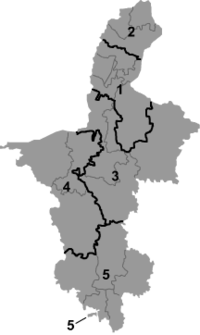 | ||||||||||
| № | Division code[15] | English name | Chinese | Pinyin Xiao'erjing |
Area in km2[16] | Population 2010[17] | Seat | Divisions[18] | ||
| Districts | Counties | CL cities | ||||||||
| 640000 | Ningxia Hui Autonomous Region |
宁夏回族自治区 | Níngxià Huízú Zìzhìqū نٍ شيَا خُوِ ذُوْ ذِ جِ ثُوْ |
66000.00 | 6,301,350 | Yinchuan | 9 | 11 | 2 | |
| 1 | 640100 | Yinchuan | 银川市 | Yínchuān Shì ىٍﭼُﻮًا شِ |
9555.38 | 1,993,088 | Jinfeng District | 3 | 2 | 1 |
| 2 | 640200 | Shizuishan | 石嘴山市 | Shízuǐshān Shì شِذُﻮِشً شِ |
1213.09 | 725,482 | Dawukou District | 2 | 1 | |
| 3 | 640300 | Wuzhong | 吴忠市 | Wúzhōng Shì ءُﺟْﻮ شِ |
20394.30 | 1,273,792 | Litong District | 2 | 2 | 1 |
| 5 | 640400 | Guyuan | 固原市 | Gùyuán Shì ﻗُﻮْﻳُﻮًا شِ |
14412.83 | 1,228,156 | Yuanzhou District | 1 | 4 | |
| 4 | 640500 | Zhongwei | 中卫市 | Zhōngwèi Shì ﺟْﻮوِ شِ |
16824.41 | 1,080,832 | Shapotou District | 1 | 2 | |
The five prefecture-level divisions of Ningxia are subdivided into 22 county-level divisions (9 districts, 2 county-level cities, and 11 counties).
Economy

Ningxia is the province with the third smallest GDP (Tibet being the last) in China, even though its neighbors, Inner Mongolia and Shaanxi, are among the strongest emerging provincial economies in the country.[19] Its nominal GDP in 2011 was just 200.0 billion yuan (US$32.7 billion) and a per capita GDP of 21,470 yuan (US$3,143). It contributes 0.44% of the national economy.[19]
Unlike several other underdeveloped provinces, labor costs in Ningxia are among the highest in China (ranking in the top third percentile), making it unattractive as a manufacturing center. Furthermore, Ningxia has yet to become a hub for consumption due to its low population.[19]
Ningxia is the principal region of China where wolfberries are grown. Other specialties of Ningxia are licorice, products made from Helan stone, fiddlehead and products made from sheepskin.
Yinchuan Economic and Technological Development Zone[20] was established in 1992. Spanning 32 km2 (12 sq mi), it has an annual economic output Rmb23.7 billion (25.1% up) (US$3.5 billion). Major investors are mainly local enterprises such as Kocel Steel Foundry, FAG Railway Bearing (Ningxia), Ningxia Little Giant Machine Tools, etc. Major industries include machinery and equipment manufacturing, new materials, fine chemicals and the animation industry.
Desheng Industrial Park (in Helan County) is a base for about 400 enterprises. The industrial park has industrial chains from Muslim food and commodities to trade and logistics, new materials and bio-pharmaceuticals that has 80 billion yuan in fixed assets. Desheng is looking to be the most promising industrial park in the city. It achieved a total output value of 4.85 billion in 2008, up 40 percent year-on-year. The local government plans to cut taxes and other fees to reduce the burden on local enterprises. The industrial output value reached 2.68 billion yuan in 2008, an increase of 48 percent from a year earlier.
Ningxia wines are a promising area of development. The Chinese authorities have given approval to the development of the eastern base of the Helan Mountains as an area suitable for wine production. Several large Chinese wine companies including Changyu and Dynasty Wine have begun development in the western region of the province. Together they now own 20,000 acres of land for wine plantations and Dynasty has ploughed 100 million yuan into Ningxia. In addition, the major oil company China Petroleum and Chemical Corporation has founded a grape plantation near the Helan Mountains. The household appliance company Midea has also begun participating in Ningxia's wine industry.[21]
Vineyards have been set up in the region.[22]
Transport

Airports
- Yinchuan Hedong Airport
- Zhongwei Shapotou Airport
- Guyuan Liupanshan Airport
- Wuhai Airport (serves the northern area)
Highways
- China National Highway 109
- China National Highway 110
- China National Highway 211
- China National Highway 307
- China National Highway 309
- China National Highway 312
Bridge
- Taole Yellow River Expressway Bridge (陶乐黄河大桥)
Rail
- Baotou-Lanzhou Railway (包兰铁路)
- Baozhong Railway (宝中铁路)
Education
Demographics
| Historical population | ||
|---|---|---|
| Year | Pop. | ±% |
| 1912[23] | 303,000 | — |
| 1928[24] | 1,450,000 | +378.5% |
| 1936-37[25] | 978,000 | −32.6% |
| 1947[26] | 759,000 | −22.4% |
| 1982[27] | 3,895,578 | +413.3% |
| 1990[28] | 4,655,451 | +19.5% |
| 2000[29] | 5,486,393 | +17.8% |
| 2010[30] | 6,176,900 | +12.6% |
| Ningxia Province/AR was part of Gansu 1914-1929 and 1954-1958 In 1947 parts of Ningxia Province/AR were incorporated into Inner Mongolia AR. | ||
Religion
Religion in Ningxia (around 2010)
The major religions in Ningxia are Islam among the Hui Chinese, while many of the Han Chinese practice Chinese folk religions, Taoism, Confucianism and Chinese Buddhism. According to a demographic analysis of the year 2010, Muslims form 34% of the province's population.[31] Christianity is the religion of 1.17% of the province's population according to the Chinese General Social Survey of 2004.[32]
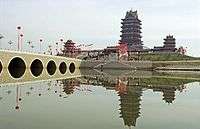
Hospitals
- People's Hospital of Ningxia
- Hospital of Traditional Chinese Medicine of Ningxia
- Ningxia Medical College Affiliated Hospital
- Yinchuan Hospital of Traditional Chinese Medicine
- Yinchuan People's Hospital
- Yinchuan Stomatological Hospital
- Yinchuan Women and Children's Healthcare Center
- Women and Children's Healthcare Center of Ningixa
- Yinchuan No.1 People's Hospital
- Yinchuan No.2 People's Hospital
- Yinchuan No.3 People's Hospital
- Shizuishan No.2 People's Hospital
- Guyuan Hospital of Ningxia
Tourism
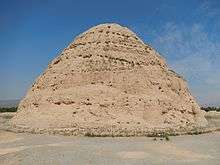
One of Ningxia's main tourist spots is the internationally renowned Xixia Tombs site located 30 km (19 mi) west of Yinchuan. The remnants of nine Western Xia emperors' tombs and two hundred other tombs lie within a 50 km2 (19 sq mi) area. Other famous sites in Ningxia include the Helan Mountains, the mysterious 108 stupas, the twin pagodas of Baisikou and the desert research outpost at Shapatou. A less visited tourist spot in Ningxia is the Mount Sumeru Grottoes (须弥山), which is among the ten most famous grottoes in China.[33]
Museums
- Ningxia Museum, opened in 1988
- Ningxia Transportation Museum, opened in August 2008
See also
References
- 1 2 "Administrative Divisions (2013)". Ningxia Statistical Yearbook 2014. Statistical Bureau of Ningxia. Retrieved 19 December 2015.
- ↑ "Communiqué of the National Bureau of Statistics of People's Republic of China on Major Figures of the 2010 Population Census [1] (No. 2)". National Bureau of Statistics of China. 29 April 2011. Retrieved 4 August 2013.
- ↑ "National Data". National Bureau of Statistics of China. Retrieved 19 December 2015.
- ↑ "《2013中国人类发展报告》" (PDF) (in Chinese). United Nations Development Programme China. 2013. Retrieved 2014-05-14.
- ↑ "By choosing assimilation, China's Hui have become one of the world's most successful Muslim minorities". The Economist. 8 October 2016. Retrieved 8 October 2016.
- ↑ Xu Xin, The Jews of Kaifeng, Ktav Publishing House, c. 2003.
- ↑ China Archaeology and Art Digest, Volume 3, Issue 4. Art Text (HK) Ltd. 2000. p. 354. Retrieved 2010-11-28.
- ↑ "Fourteen dead in mosque crush in China's Ningxia region". BBC. 6 January 2014.
- ↑ yan, ed. (2014-01-06). English.news.cn (Xinhua). BEIJING http://news.xinhuanet.com/english/china/2014-01/06/c_133020252.htm. Missing or empty
|title=(help) - ↑ Close, U., and McCormick (1922) "Where the mountains walked" National Geographic Magazine 41(5): pp.445–464.
- ↑ Feng, X. and Guo, A. (1985) "Earthquake landslides in China" In Proceedings, IVth International Conference and Field Workshop on Landslides pp. 339–346, Japan Landslide Society, Tokyo, OCLC 70324350.
- ↑ Haines, Lester (19 July 2006)."Chinese black helicopters circle Google Earth". The Register
- ↑ Cassidy, Katherine (13 September 2006). "Armchair Sleuths Uncover Strange Military Sites in China". McClatchy Newspapers / Real Cities Network.
- ↑ "Ningxia og Sogn og Fjordane eit steg vidare på samarbeidsvegen". Sfj.no. Retrieved 2015-05-07.
- ↑ "中华人民共和国县以上行政区划代码". 中华人民共和国民政部.
- ↑ 深圳市统计局. 《深圳统计年鉴2014》. 深圳统计网. 中国统计出版社. Retrieved 2015-05-29.
- ↑ shi, Guo wu yuan ren kou pu cha ban gong; council, Guo jia tong ji ju ren kou he jiu ye tong ji si bian = Tabulation on the 2010 population census of the people's republic of China by township / compiled by Population census office under the state; population, Department of; statistics, employment statistics national bureau of (2012). Zhongguo 2010 nian ren kou pu cha fen xiang, zhen, jie dao zi liao (Di 1 ban. ed.). Beijing Shi: Zhongguo tong ji chu ban she. ISBN 978-7-5037-6660-2.
- ↑ 中华人民共和国民政部 (August 2014). 《中国民政统计年鉴2014》. 中国统计出版社. ISBN 978-7-5037-7130-9.
- 1 2 3 "China Economy @ China Perspective". Thechinaperspective.com. Retrieved 2015-01-29.
- ↑ "欢迎访问银川经济技术开发区网站". Ycda.gov.cn. 2015-04-24. Retrieved 2015-05-07.
- ↑ "Grape expansion: Chinese wine companies move west", Want China Times, 15 December 2011. Retrieved 17 December 2011.
- ↑ Phillips, Tom (14 June 2016). "China's Bordeaux: winemakers in 'gold rush' to turn desert into vineyards". The Guardian. Helan county, Ningxia province.
- ↑ "1912年中国人口". Retrieved 6 March 2014.
- ↑ "1928年中国人口". Retrieved 6 March 2014.
- ↑ "1936-37年中国人口". Retrieved 6 March 2014.
- ↑ "1947年全国人口". Retrieved 6 March 2014.
- ↑ "中华人民共和国国家统计局关于一九八二年人口普查主要数字的公报". National Bureau of Statistics of China.
- ↑ "中华人民共和国国家统计局关于一九九〇年人口普查主要数据的公报". National Bureau of Statistics of China.
- ↑ "现将2000年第五次全国人口普查快速汇总的人口地区分布数据公布如下". National Bureau of Statistics of China.
- ↑ "Communiqué of the National Bureau of Statistics of People's Republic of China on Major Figures of the 2010 Population Census". National Bureau of Statistics of China.
- 1 2 Min Junqing. The Present Situation and Characteristics of Contemporary Islam in China. JISMOR, 8. 2010 Islam by province, page 29. Data from: Yang Zongde, Study on Current Muslim Population in China, Jinan Muslim, 2, 2010.
- 1 2 China General Social Survey 2004. Report by: Xiuhua Wang (2015, p. 15)
- ↑ "Guyuan Travel Guide: Map, Location, Climate, Attractions". Travelchinaguide.com. Retrieved 2015-01-29.
External links
- Ningxia Provincial Government
- Ningxia Agricultural Information Network
- Ningxia Investment Promotion Bureau
- Britnannica Ningxia
- Economic profile for Ningxia at HKTDC
- Profile of Ningxia at china.org.cn
- Ningxia 2004 - The Year in Review
- Ningxia 2005 - The Year in Review
- Ningxia Profile - UNESCAP
- Ningxia Center for the Environment and Poverty Alleviation
- Ningxia Profile - China Economic Information Network
- Ningxia (autonomous region, China) -- Britannica Online Encyclopedia
 |
Inner Mongolia |  | ||
| Gansu | |
Shaanxi | ||
| ||||
| | ||||
| Gansu |
.svg.png)
.svg.png)


